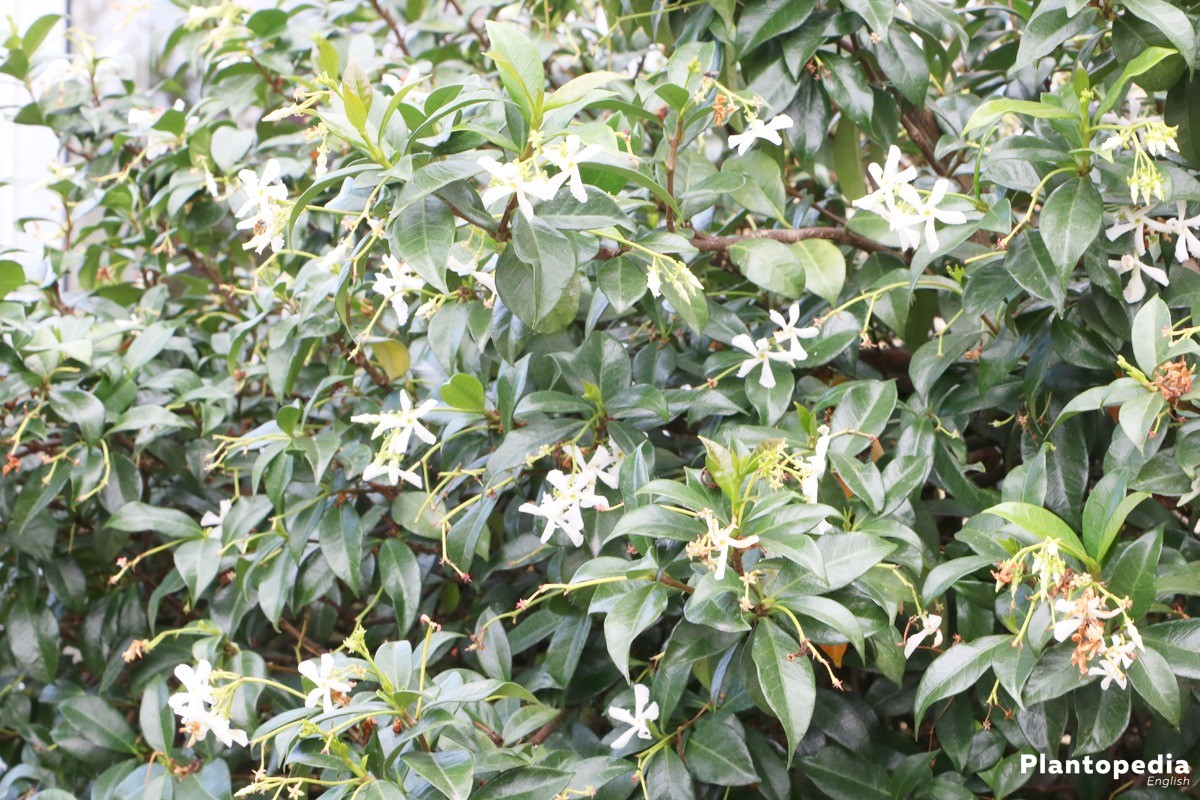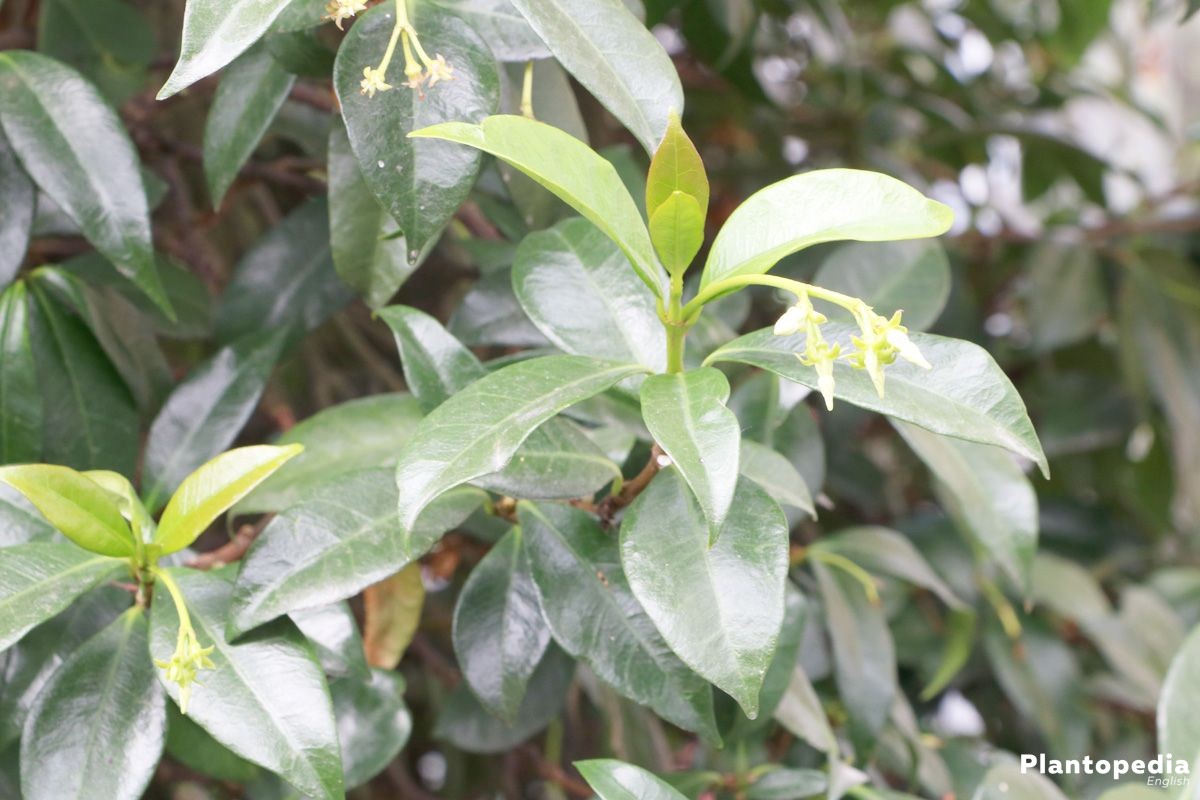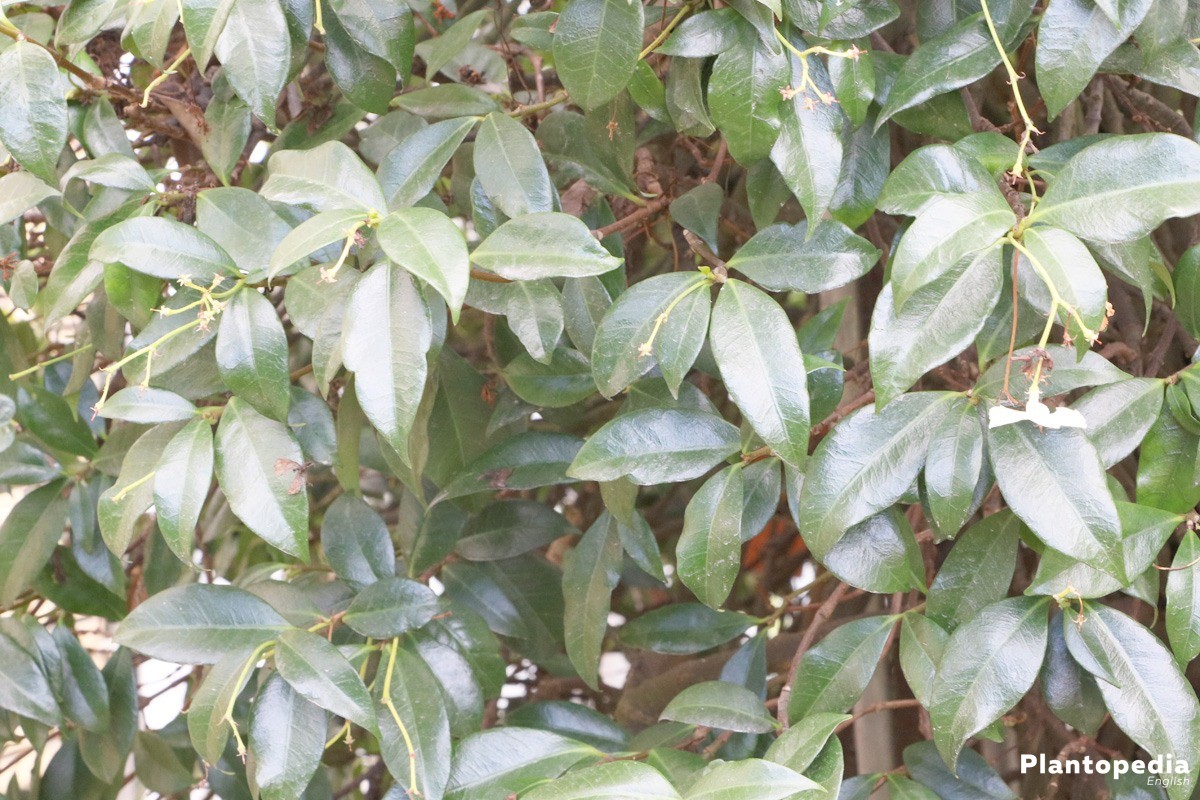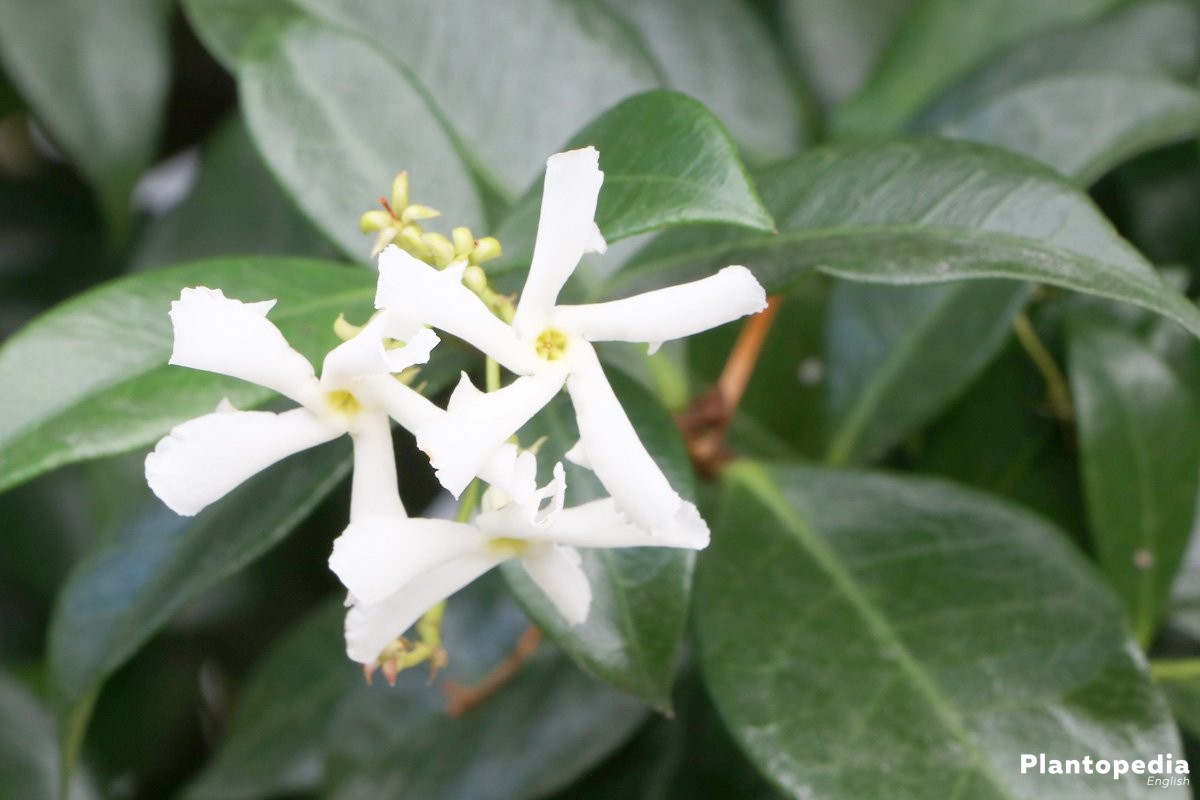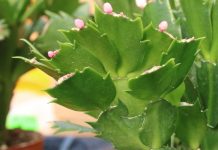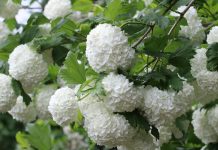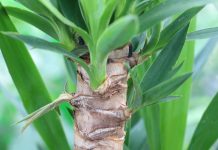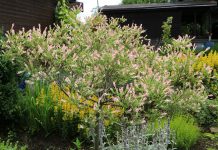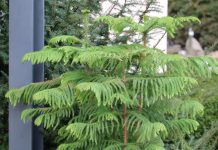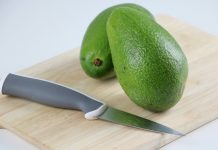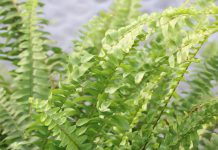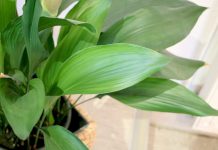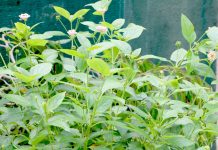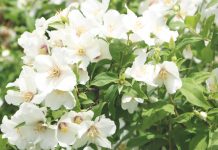The jasmine plant impresses with its lush flowering with countless white or yellow star blossoms distributing their sweet fragrance. Despite not being winter-durable and needing a cool place for winter from October to March, it is undemanding and easy to take care of. If one follows the tips in these care instructions, even beginners enjoy this plant for years.
Plant Profile
Contents
- Plant family: olive family (Oleaceae)
- Genus: jasmine (jasminum)
- Species: Jasminum officinale
- Trivial name: common jasmine (Jasminum officinale)
- Origin: tropics, sub-tropics, Mediterranean area
- Delicate, undemanding climbing plant
- Height: 100 – 300 cm
- Flowering period: June to September
- White or yellow star flowers with sweet scent
- Green lilac leaves, yellow fall coloration
- Black berry fruit in fall
- Cool, sunny place
The jasmine plant is very popular due to its sweet scent, not only as an interior pot plant. Jasmine can also be held outside in a sunny place from April to September. Here, the white or yellow star blossoms form an attractive contrast to the green lilac leaves.
As a climbing plant, it appreciates scaffold structures or espaliers since the jasmine’s long shoots use them to hold on to. In this caretaking instruction, there are all details for proper caretaking of this popular scented plant.
Care
With the right place and proper care, one can have fun with the undemanding jasmine plant for years. The needs and wishes of the plant are well met with the following care instructions.
Place
The jasmine plant shows its lush blossoming best in a sunny, cool place. It is often held in buckets or pots on a roofed balcony or a protected terrace close to a group of seats due to the scent of the blossoms. The plant needs shadowing if it is directly put into midday sun since the glass of the windows intensifies the solar light beams, which can lead to damage to the leaves.
Also, cold passage of air should absolutely be avoided, as the jasmine plant does not tolerate it well. To enjoy the jasmine plant as long as possible, one should consider the following conditions if the plant is put outside from April on.
- Sunny, cool place with as many sun hours as possible
- Protection from heavy rain (e.g. with a wall, hedge, slope), but without shadowing
- Slow adaptation to UV-radiation after overwintering
- Ideal temperature from April to October: 18 – 22°C
- Scaffold structures for the long to shoots of the jasmine plant to hold on to
- Important: sufficient ventilation, to prevent diseases and pest infestation
Soil Properties
The jasmine plant likes almost every soil that is humous, permeable and rich in nutrients. Sufficient water drainage has to be ensured to avoid waterlogging.
Substrate
As a pot plant, the jasmine plant does not require any special properties of the soil and grows in almost every soil. However, the substrate should be loose and permeable. A slightly acidic pH of the substrate is perfect and can be achieved by adding bog garden soil. Furthermore, the substrate can be enriched with lava granulate or foam clay to improve permeability in the bucket. In the summer, the jasmine plant also accepts high-quality garden soil, which is rich in nutrients, humous and permeable.
Planting Period
The jasmine plant should not be planted or repotted before the end of overwintering. This period lasts from October to March and the plants are supposed to rest. They regain energy for growth and flowering in the following year and should therefore be left alone and should not be repotted.
Planting in Beds
While overwintering, the jasmine plant is held as a pot plant. But it can also be planted in the garden without any problems. However, it should not be planted before the danger of soil frost is not present anymore. The planter should also take care of drainage while planting in a bed so that excess water can be drained and waterlogging is avoided. In the beds, it is suggested to install trellises, espaliers or round arches for the long plant shoots of climbing plants.
Planting in Pots
Jasmine plants that are held as interior plants, should be repotted regularly due to the great nutrient turnover. Repotting should be independent of if the respective pot became too small or not. Younger plants need a new pot every year for their development. Older plants, however, only need repotting every 2-3 years. The new pot’s diameter should be not more than 10 cm larger than the old one.
Watering
A balanced water supply is important for growth of the jasmine plant. Thus, the following should be given for proper watering.
- Use collected rain water or decalcified tap water
- Use lukewarm water to avoid damage due to shock of coldness
- Water the plant in the morning and in the evening on warm summer days if needed
- Spray lukewarm, calcium-free water on the leaves on hot days or dry air
- Absolutely avoid waterlogging
- Concerning pot plants, dispose excess water in the pot 10 minutes after watering
- Install drainage for water in beds
Since the jasmine plant tolerates moisture better than drought, the substrate should be kept moist all the time. During growth and flowering, the jasmine plant needs more water and should be watered daily from April to September. However, watering should be reduced in the time of overwintering.
Fertilization
For a proper dress of flowers and lush blossoming, the jasmine plant needs sufficient supply with nutrients. Thus, the weekly application of fluid fertilizers or fertilizing sticks is necessary from April to the beginning of September.
Pruning
The pruning of the jasmine plant is defined by the period of blossoming and is usually done after overwintering. Maintenance pruning should be performed annually to control the degree of lignification.
- Long shoots are reduced by ⅔ of their lengths. Each cut is done slightly above an outward facing node
- The whole plant is sufficiently pruned
- Dry, lean shoots are cut at the base
Simultaneously, the jasmine plant’s drive to blossom is enhanced since new blossoms exclusively form at young shoots. The flowering will reduce to few buds at the end of the sprouts if no cutting is done for several years. This makes radical cutting necessary, which is also performed after overwintering. All shoots are cut to ⅓ of their original length. In the following year, no blossoms will form, but re-appear in 1-2 years.
Overwintering
Outside, the jasmine plant tolerates frost only for a short period and has to be relocated into a winter quarter as soon as the temperature constantly drops under 15° C. Even the jasmine plants that are held inside for the whole year need overwintering to form new blossoms in summer.
The following conditions should be given for proper overwintering:
- Bright, cool place; temperatures of 10° C are ideal
- No fertilizing of the jasmine plant from October to March
- Reduce watering, but keep the root bales moist
- Regularly ventilate the winter quarter
- Regularly check the plant for pests
The resting period from October to March is especially important for the new blossoming in the following year. Even if the jasmine plant loses its leaves in the winter quarter, one should not be concerned as this is a normal process. They will re-sprout in the next period of vegetation.
As soon as the danger of belated frost is not present anymore, the jasmine plant can be moved outside again. However, it should be gradually accustomed to the sun and be kept in a shadowed place for a couple of days at first before moving it to its final place.
Propagation
Cuttings or the sowing of seeds can multiply the jasmine plant. The seeds can be gained from the jasmine berries. Yet, the jasmine berries contain only a few seeds, which is why it can be hard to buy them in specialist shops.
Sowing
Sowing with self-harvested semen can be done throughout the whole year. The seed of the jasmine plant should be soaked in chamomile tea for at least 24 hours before sowing. This is necessary since they are equipped with budding inhibition within the pulp.
Then, the following steps can be carried out:
- Fill the sowing bowl with peat sand, humus with coconut fibers or perlite and moisten
- Sow the jasmine seeds at least 5 cm apart from each other
- Cover the jasmine semen with a maximum of 1 cm with substrate of vermiculite
- Keep the plant constantly most in a heatable greenhouse at 22-25° C
Germination of the jasmine semen takes about 3-6 weeks. The seeding material must not become too dry or too moist. As soon as the first cotyledons appear, the temperature is lowered to 20° C.
- Prick seedlings as soon as the first pair of leaves is visible
- Fill small pots with pricking soil and press a trough into it with the pricking stick
- Carefully plant the jasmine seedlings in the center and fill with pricking soil up to the cotyledons
- Water from below with decalcified, lukewarm water
- Half-shadowed, warm place at a window
- Start fertilizing at 30 cm height
Cuttings
Not lignified, foliated shoots without blossoms from the center of the plant make for good cuttings.
The 15-20 cm long cuttings should be prepared like this:
- Remove all leaves except for the one at the very top
- Plant ⅔ in a planting pot with lean substrate
- Water with lukewarm rain water or decalcified tap water
A hood is put over the cutting to establish a moist-warm microclimate. Also, the place should be shadowed and the temperature should be 20° C. The substrate constantly has to be kept moist and the hood has to be ventilated for 20 minutes every day in order to avoid mold. As soon as the first fresh budding shows, the hood can be removed. Planting into bigger vessel occurs as soon as the young plant completely rooted in the vessel.
Diseases
Not taking care of plants is often the cause for diseases and pest infestation. An example is watering with calcium-containing water. This can lead to the disease leave chlorosis since the jasmine plant does not resorb the required amount of iron. Root rot is caused by insufficient ventilation and waterlogging, which is a sign of excessive watering. If the jasmine plant gets too little water, it loses its blossom buds and leaves.
Pests
Mealybug
Mealybugs occur once in a while when dealing with jasmine plants. They form white-woolish knobs that are 3-4 mm in size. They sit in the leaf axis or at the stem. They can be removed with oil-containing materials.
Aphid
Aphid often infests jasmine plants, especially if they are put outside or it is too warm during overwintering. Mostly, aphids can be sprayed on with decalcified water and a little bit of paraffin oil, before using pesticides.
Species
There are more than 200 species of jasmine plants worldwide. Beside the common jasmine (J. officinale), the following are also popular.
Arabian jasmine (J. sambac)
- more robust than Real jasmine, can blossom throughout the whole year, has larger, more scenting blossoms
Chinese jasmine (J. grandiflorum)
- very rich in blossoms, good for interior use, used for aromatizing of green tea
White or pink jasmine (J. polyanthum)
- evergreen, rapidly growing climbing plant
Primrose jasmine (J. promulinum)
- yellow blossoming, evergreen shrub, early blossoming in February/ March
Winter jasmine (J. nudiflorum)
- winter-durable, long, drooping branches and yellow blossoms in winter, no blossom fragrance
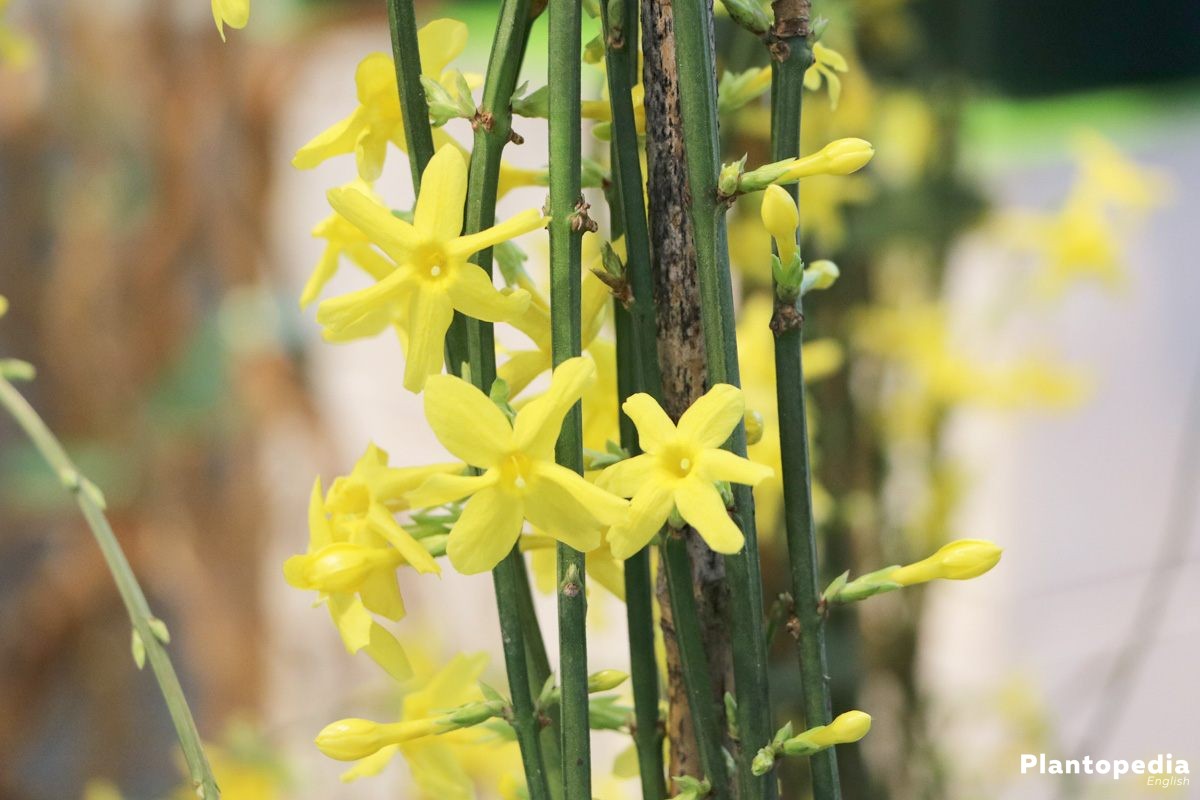
Indian jasmine (J. species)
- climbing plant with white blossoms, magnificent scent
Shrub jasmine (J. fruticans)
- evergreen shrub, upright growth, frost-sensitive


